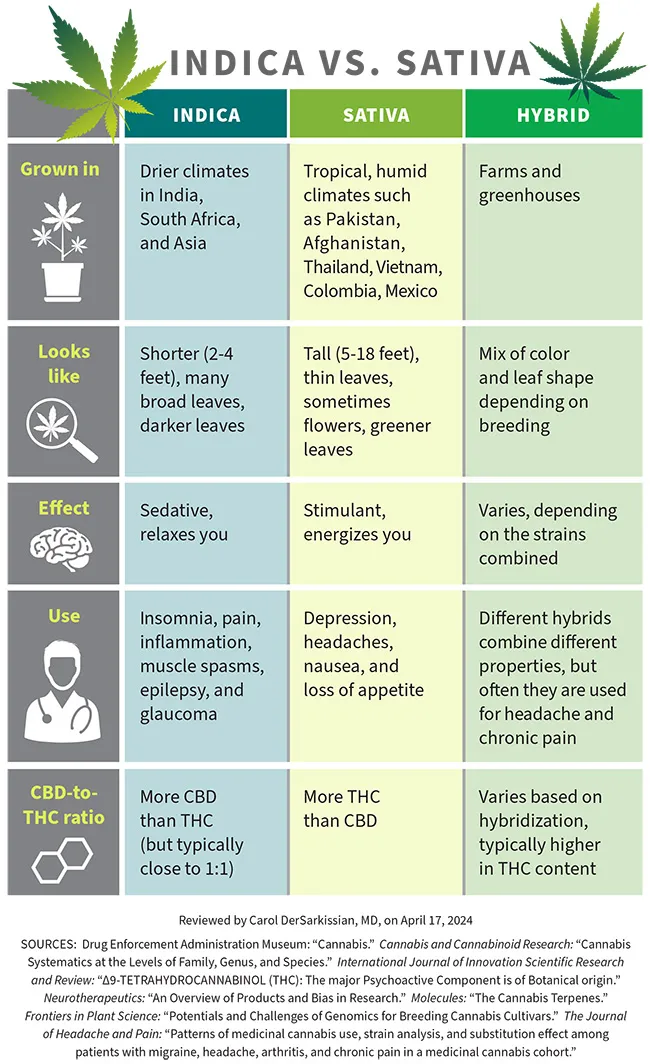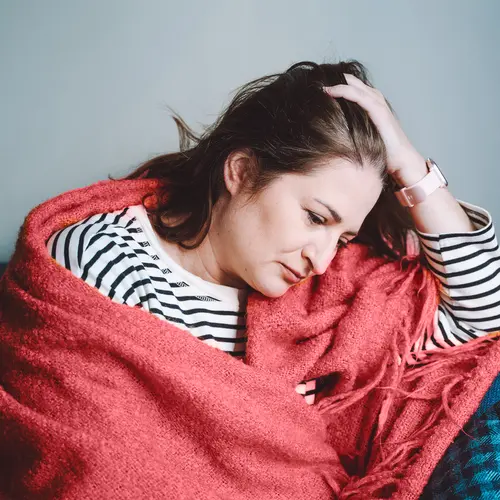Cannabis indica and Cannabis sativa are two types, or strains, of the cannabis plant. The dried leaves, flowers, stems, and seeds of cannabis are what make up marijuana, or weed. Cannabis plants have over 100 compounds, including tetrahydrocannabinol (THC), which causes a “high,” and cannabidiol (CBD), which does not.
As plants, the two strains look different. Indica is a shorter plant with broader leaves and a woody stalk. Sativa is tall with thin leaves, and they grow more quickly. There are also many types of hybrid plants with properties of both strains.
Sativa and indica are closely related, but they have differences. Each has a different ratio of CBD to THC, and that can change how they affect your body. But plant strain is only one of the things that impact this. Certain terpenes (compounds behind how some plants taste and smell) can affect mood, energy, and come in different quantities in different strains.

Even though the strains are different physically and chemically, experts say you can’t look at a cannabis plant and predict how it will affect your body. These plants have been bred and hybridized for so long that some researchers now say there isn’t a clear distinction between the two.
In fact, one study found that strains labeled as indica were just as closely related to strains labeled sativa as they were to other indica strains.
Most of the strains you find on the market these days are hybrids, and most are bred to increase the level of THC. But experts also say that another important part of how a strain will make you feel – or how it may be used to treat certain medical conditions – is the combination of cannabinoids and terpenes.
Some cannabis terpenes are:
- Linalool
- Myrcene
- Limonene
- Alpha-pinene
Because cannabis hybrid strains – mixed breeds of both sativa and indica – are so prominent, often weed types are called “indica-dominant” or “sativa-dominant.” With that in mind, here are some facts about the original, pure versions of these weed strains.
What Is Indica?
The cannabis indica strain originally comes from dry climates in India, South Africa, and Asia. It generally has a higher CBD content than cannabis sativa, but the CBD-to-THC ratio is very close to 1:1. People often describe its smell as “skunky.” Indica is also known as hemp.
Indica Effects
The higher CBD content in indica can mean that for many people, it causes a relaxing, soothing feeling in the body. But experts also point to its higher levels of the terpene myrcene as a reason for a sleepy feeling. For this reason, some people choose to take this strain in the evening hours.
Indica Uses
Many medical cannabis strains contain a hybrid form of the indica strain. Some of the more common situations people use it for include:
- Non-migraine headaches
- Nerve pain or numbness
- Spasticity
- Joint pain
- Arthritis
- Insomnia
- Chronic pain
- Fatigue
- Low appetite
Indica Strains
Many cannabis indica strains are cultivated in Afghanistan for hashish. Some strains include:
- Afghan Kush
- Skywalker OG
- Purple Sunset
- Northern Lights
- Afghan Kush
- L.A. Confidential
- Guru #10
What Is Sativa?
Sativa comes from tropical, humid climates such as Pakistan, Afghanistan, Thailand, Vietnam, Colombia, and Mexico. Sativa’s lower myrcene content makes it more likely to energize you. Sativa is more commonly known as the recreational type of cannabis, or marijuana.
Sativa Effects
Because sativa has more THC than CBD, it tends to cause a mind-altering effect. This typically makes people feel euphoric and stimulated. It may also reduce anxiety.
Sativa Uses
Sativa’s “mind-high” properties mean it’s often the choice for recreational use. But some people use it for medical purposes, too. It may help with:
- Stress
- Nausea
- Acute pain
- Mental fog
- Anxiety
- Depression
- PTSD
- Migraine
- Glaucoma
- Headache
- Low mood
Some research on animals shows that sativa strains can have as significant an effect on depression as selective serotonin reuptake inhibitor (SSRI) medication. But more research is needed to study its effects on people.
Because medical marijuana is not legal everywhere, the scientific evidence of how it works on certain conditions is slim. There is no evidence that marijuana treats conditions themselves, simply the symptoms.
Sativa Strains
Some of the more popular sativa strains include:
- Dutch Hawaiian
- Super Silver Haze
- Maui Waui
- White Buffalo
- Sour Diesel
- Dream N’ Sour
- Jack Herer
Takeaways
- Indica and sativa are two strains of cannabis, the plant used to make marijuana.
- These strains are physically different from each other, but experts say that because of the vast amount of hybridization of the two strains, their appearance can’t accurately predict how they’ll affect your body.
- Still, certain properties of other compounds in different strains, such as terpenes and cannabinoids like CBD and THC, change how different types of cannabis make you feel.
- Some strains give you more of a body high that relaxes you, while others are more likely to give you a mind high that sharpens your focus and alters your thinking.
Indica vs. Sativa FAQs
Which is better: sativa or indica? The effect a strain has on you depends on many things. The one that’s “better” for you largely depends on the effect you’re after. A large survey found that indica is preferred when treating symptoms and reducing pain. Sativa strains are the choice for recreational use, or a “high.”
Does sativa or indica make you sleepy? Indica has higher amounts of the terpene myrcene, which creates a sedative effect. Scientists call this the “couch-lock” effect. In general, if your strain of cannabis is more than 0.5% myrcene, your energy will be lower and you’ll feel calmer. If it’s lower than 0.5%, you’ll feel more energetic.
Is sativa an upper or downer? In general, sativa strains are known as stimulants that energize you as an “upper.” But experts are moving away from this simplification between the strains because they’re so often hybrids with varying amounts of THC, CBD, and other compounds. Sativa tends to have less of the terpene myrcene than indica, which energizes you.
Is indica a body high? In surveys of people who regularly use weed, indica strains are more likely to cause a “body high.” A body high changes the way your body feels, often resulting in a feeling of relaxation and sometimes pain relief. Another type of high is a head high, a state where you become more interested in the world around you and feel euphoric, or “trippy.” Sativas are typically considered more likely to produce a head high, meaning they stimulate your mind but don’t leave you feeling heavy or sleepy.
Does sativa make you hornier than indica? In general, any strain tends to have a positive effect on your sexual satisfaction. But some studies show that too much THC can dampen your libido. Since sativa has a higher THC-to-CBD ratio than indica, it may not be the better bet for increasing your sexual desire.
Which strain gives you giggles? Sativa is more likely to cause euphoria, along with an energy boost, so you may find yourself feeling more tickled on it than if you take the more relaxing indica.

